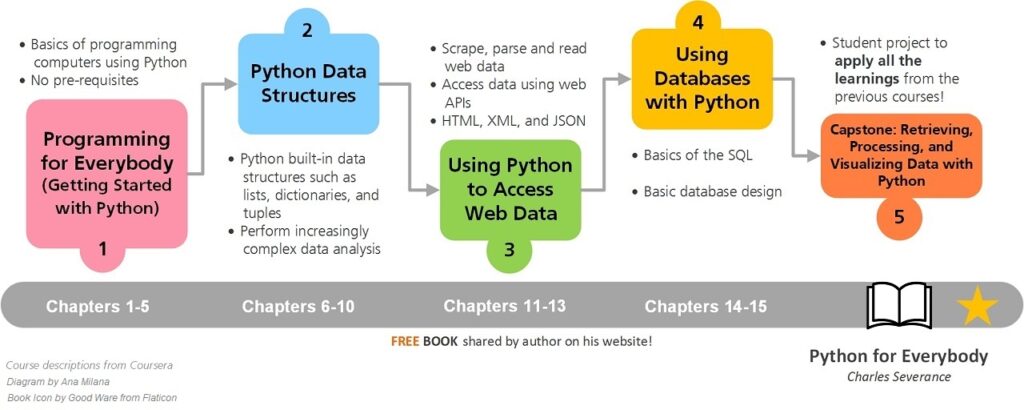Python has rapidly become one of the most popular and versatile programming languages in the world, being particularly in demand for Data Science and Machine Learning.
If you want to learn Python to get started into Data Analysis, I strongly recommend the below courses taught by the amazing (Dr.) Charles (“Chuck”) Severance. These 5 courses are part of the Python for Everybody Specialization offered by the University of Michigan via Coursera, though they can be taken separately and in any order that you prefer.

What will you learn in each course
Dr. Chuck will first take you through the python basics in Courses 1 and 2 – if you are new to Python, Course 1 is definitely a good place to start. It might seem somewhat “basic” at times, but bear in mind it’s best to have a solid foundation of the basics before venturing into more complex ones!
Once you are familiarised with this, Course 3 will teach you how to build web crawlers and access data through different website’s APIs (eg. the Twitter or Google Maps APIs). Dr. Severance will also teach you how to parse data (eg. using Regex) available in HTML, XML and JSON formats – Hint: if you’re planning to get into data science, it’s quite important to know how to work with APIs to retrieve specific data! Also, you should be comfortable with the different data formats that will be served to you by different APIs.
For a data scientist/analyst, getting the data is only part of the equation: they must also know how to store and handle the data. In Course 4, you will learn how python can be used to store any downloaded data into SQLite databases. You will also learn how to query such databases, again through python commands.
I haven’t taken Course 5 yet so cannot give you more info about it. I will update this post later on once I have completed that course.
Links to the Coursera Python courses
Note: As per my latest knowledge, any course can be audited for free on the Coursera platform (i.e. anyone can watch the lecture videos), but people cannot access the assignments and quizzes unless they pay a given Coursera subscription.
More resources to keep learning

The above courses follow Dr. Chuck’s Python for Everybody book – the above diagram shows which chapters are covered by each online course.
The amazing Charles Severance has created his own website (“Python for Everybody” or “PY4E”) where he has shared a FREE version of his Python for Everybody book – so you can access it at your own pace.
The book is available in a variety of formats (eg. as a PDF, an HTML version and some interactive formats) and languages, so you pick the one that best suits your needs.
Sidenote: Another book from Dr. Chuck (not limited to Python) is Introduction to Networking, which is a great resource to understand the architectural components behind how networks work. This is a good companion to the 3rd course above if you want to deepen your networks and Internet understanding.
